Protection Required
It’s expressed multiple times throughout the Code; protect the wires, cables, conductors from physical damage. As electricians and inspectors are trained, there are many common concepts which should be taught. These concepts repeat throughout theCode, and once explained, along with practical field work and further code study, help electrical professionals to better understand and apply the Code.
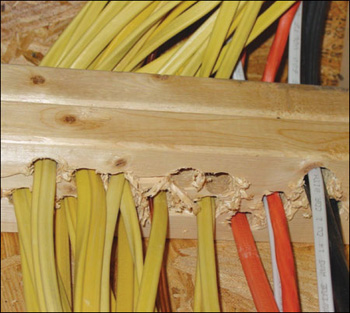
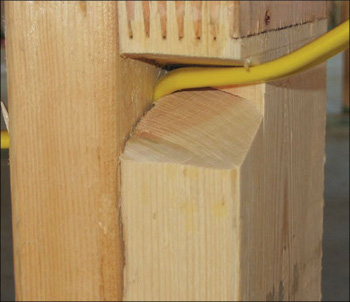
Conductors
A couple of the most common situations come with NM cable placed less than 1¼”” from the edge of a framing member. Cable must be kept back to lessen the likelihood of penetration by a nail or screw; and if it is installed in wood framing, nailplate(s) or a conduit type sleeve may be required. Also, when rounding corners, or where wood or steel framing has been cut or notched, care must be taken to avoid pinching and hard twists or rolls in NM cable.
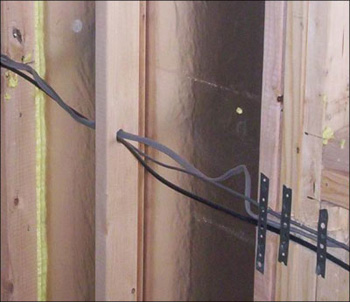
Photo 3. NM cable with inadequate protection; 1/16″ thick nailplates are required.
Nonmetallic sheathed cables such as Types NM, UF, CMP, Fire Alarm, etc., installed in metal framing all require physical protection from sharp metal edges. Plastic type grommets listed for the use are commonly utilized for this purpose. A major electrical jurisdiction in the Northwest requires a two-piece grommet, to assure that the grommet stays in place once installed and cable is pulled through the wall, etc. This serves as a good reminder for contractors and engineers to check for any local laws or requirements that supplement the adopted NEC in a jurisdiction. When any of these types of nonmetallic cables, or electrical nonmetallic conduit, for example, has been installed in metal framing in a commercial building, they must meet the same requirements. Nailplates 1/16″” thick must be installed where the closest edge of the hole is less than 1¼”” from the edge of the metal framing member, (and the metal framing itself is less than 1/16″” thick). Wiring methods must generally be kept at least 1¼”” back from the edges of framing members, or protected by RMC, IMC, Rigid PVC, EMT, or furring strips.
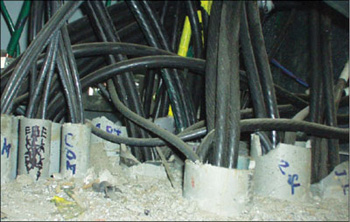
Photo 4. Abrasion to conductors caused by untrimmed edges of PVC conduit.
Cables stapled too tightly into wood framing are another cause of physical damage, and with overcurrent protection and grounding violations, have been known to start fires. Staples are sometimes driven into the cable insulation and conductors with such force that the cable suffers a ground fault or short circuit. This can also occur when a cable such as NM cable is stapled on edge, which is a code violation and is why this practice is not permitted. When a staple is installed, the cable needs to be secured, but is permitted to be able to be moved slightly under the staple. The same goes for communications cables, where pinching the cable by driving the staple into the wood too far, for example, has caused poor performance of Cat 5 or CATV cables.
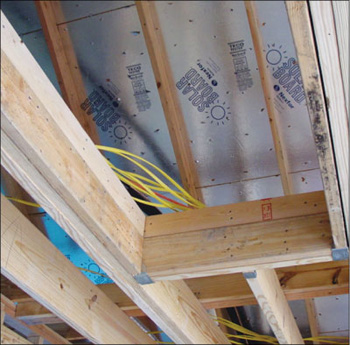
Photo 5. NM cable not secured nor protected by running boards near attic access opening
Cable connections to boxes are important, so that the nonmetallic sheath or metal cable armor of the cables is secured and grounded, and there is no abrasion to the conductor insulation. Cables must be properly secured to the box by a listed clamp.
AFCI requirements have increased in homes inNEC-2008. AFCI protection and/or protection by metallic raceway or cable wiring methods for 15- and 20-ampere 120-volt dwelling unit branch circuits has greatly increased electrical safety in dwelling units. An AFCI circuit breaker protects the entire branch circuit within the walls, ceilings, and floors, as well as in wiring plugged into the receptacles and in other electrical equipment in use. These devices augment physical protection in a structure’s electrical system.
Cables installed above suspended ceilings are often subject to physical damage when they not properly supported and are left lying on top of the ceiling tile. They could be damaged by sharp edges of T-Bars, fluorescent or other luminaires, by sharp edges of metal support wires, boxes, raceways, or supports, and by HVAC ducting, metal framing, wall penetrations, etc. Life safety system communication or signaling conductors such as telephone or code blue emergency response communication systems in a hospital have been cut, damaged, or made inoperable by physical damage, and persons have suffered injury and death because of the signal not getting through to fire or police departments, or to medical personnel when needed.
Conductors in Raceways
To start with, conductors installed in raceways must comply withNEC300.17, which states that where conductors are installed in a raceway, the number and size must not be more than will permit dissipation of the heat [generated by current flow through the conductor(s)], and one must be able to readily install or remove conductors from the raceway when needed. NEC 300.18 requires that the raceway be installed in a complete run before any cable or conductors are installed in it. This correlates with the requirements of Section 300.17, and avoids one classic example of misuse—NM cable being installed outdoors in white PVC (water) pipe, with the pipe slid over the cable one section of pipe at a time. PVC, in this case, could be interpreted as “pipe very crowded.”
Jamming
No, we’re not talking about playing music with a few good friends. Have you ever had a tough time pulling conductors in a raceway? You’ve kept the bends to a minimum, cleaned the debris from the conduit with a mandrel, applied plenty of wire lubricant, and the wire still jams and stops. At this point, it’s tempting to get a forklift or a more powerful tugger and “get ’er done.” However, in this case, it pays to first consider the jam ratio.” It may save you a lot of trouble and keep the conductors from being physically damaged.
Jamming and the term jam ratio are mentioned in chapter 9, table 1, FPN 2, which states, “When pulling three conductors or cables into a raceway, if the ratio of the raceway (inside diameter) to the conductor or cable (outside diameter) is between 2.8 and 3.2, jamming can occur. While jamming can occur when pulling four or more conductors or cables into a raceway, the probability is very low.”
As an example, table C.10 in Annex C permits three 8 AWG Type THWN conductors in ½” rigid PVC conduit, Schedule 40. In this example, for three conductors or more, 1/2″ PVC has an internal diameter (ID) of 0.602″ (from chapter 9, table 4), and an 8 AWG THWN conductor has an outside diameter (OD) of 0.216″” (from chapter 9, table 5).
Rigid PVC conduit, Schedule 40 installed in a straight run has an internal diameter of 0.602″, but because it may not be round but more of an oval at a bend, one conductor may slip between the other two and cause a jam as the conductors exit the bend. In a straight run, assuming no variation in the PVC’s internal diameter or in a conductor’s outside diameter, one conductor usually cannot slip between the other two, because the total of the outside diameters of the conductors (3 × 0.216 in. = 0.648 in.) is greater than the PVC’s internal diameter of 0.602″. At a bend, however, the major internal diameter of the raceway may increase due to bending to a diameter slightly larger than 0.602″, allowing the middle wire to be pulled between the outer two conductors. As the wires exit the bend and the raceway returns to its normal shape with an internal diameter of 0.602″, the wires may jam. This can also occur in straight runs where the ratio of the raceway’s internal diameter to the conductor’s outside diameter approaches 3. The jam ratio is calculated as follows:
Jam Ratio
The jam ratio is 2.78.
When pulling three conductors in a raceway, to avoid difficult conductor installations and potential conductor insulation damage due to jamming within the conduit or tubing, a jam ratio between 2.8 and 3.2 should be avoided.
Rough Edges
Conductors and cables must also be protected from rough edges of raceways. Field-cut or even some factory-cut edges may be sharp or rough, and require reaming or trimming. Section 110.7, Wiring Integrity, requires all electrical installations to be free from short-circuits and ground faults. Failure to properly ream or trim conduits can cause physical damage to the conductor. NEC Sections 342.28, 344.28, 352.28, 358.28 all require reaming or trimming of IMC, RMC, PVC, and EMT raceways.
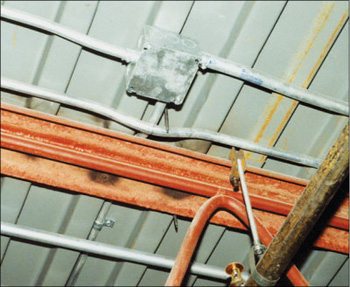
Supporting and Securing
Grounding Electrode Conductors
Grounding electrode conductors being intact is crucial to the safety of any electrical installation. Section 250.64(B) requires exposed grounding electrode conductors to be securely fastened to the surface on which they are carried, and requires 4 AWG or larger conductors to be protected where exposed to physical damage. There are also requirements relating to smaller conductors for protection by installation in a rigid raceway or cable armor. Conduit fill requirements in chapter 9 table 1 must also be consulted.

Emerging from Grade
Communications, CATV, radio and television receiving, network-powered broadband, and fiber optic system grounding conductors must also be protected from physical damage. These Code requirements are often overlooked and have been brought to light by new requirements for protection inNEC-2008.
Under Roof Decking
Cables and raceways installed under metal-corrugated sheet roof decking also require protection from screws or other mechanical devices [300.4(E)]. Roof decking may be replaced after the initial cable or raceway installation, and the screws attaching the insulation or roofing material to the corrugated sheet steel decking may penetrate the wiring methods. Boxes were not mentioned in the Code requirement, but require protection as well.
Rooftop Conduits
Rooftop conduits exposed to direct sunlight and containing conductors must meet the requirements found in 310.15(B)(2)(c). Generally speaking, the closer the conduit is in proximity to the roof, the more heat the enclosed conductors will be subjected to. An ampacity adjustment must be made, in addition to any required by higher ambient temperatures and by more than three current-carrying conductors in a raceway.
Exposed Locations
Physical protection is required in exposed locations such as a loading dock at a commercial or industrial facility, areas where forklifts are scurrying about at an industrial plant, a fruit or produce warehouse, in a driveway or parking area, and even in an indoor parking garage.
Cords
Cords used as fixed (permanent and fastened in place) wiring in a structure is another abuse/misapplication of a listed product. Flexible cords are not permitted for use as a permanent wiring method for a structure [NEC 400.8(1)]. Exposed cord can be cut, nicked or otherwise damaged when it is installed under carpets, around corners and through doors or windows, etc., and it has been the cause of hundreds of structure fires. Lengths and types of cords must be kept and maintained per the manufacturer’s listing information and requirements included with the equipment or appliance.
Motor control circuit conductors require physical protection and proper arrangement of the control system circuit to assure that motor circuits will start and stop when required, and will not be literally out of control (430.73 and 430.74). Fixed electric space heating equipment must be protected in an approved manner when subject to physical damage. For example, unit heaters installed in a locker room at a youth hockey facility require physical protection because of young men, full of vim and vigor, who are armed with hockey sticks!
Service, feeder, or branch-circuit equipment, fused and non-fused switches, electrical junction boxes or enclosures, HVAC equipment or transformers installed outdoors often require physical protection by posts, bollards, barriers, or some approved means to prevent physical damage. Concrete or heavy steel are often the best choices for protection in these locations. Equipment installed in or near driveways, alleys, parking lots, parking garages, where farming or excavating equipment is used, or along docks or wharves are examples of some locations where physical protection may be required.
Over 600 Volt Installations
Sections 110.31(D) and 490.51(C) require protection from physical damage for portable and mobile equipment by enclosures, guarding, or both. Underground splices must be protected from mechanical (physical) damage. This often includes sand bedding a trench for an underground electrical installation, regardless of voltage.
Emergency Power Systems and COPS
Section 700.9 requires wiring and generator control wiring to be kept entirely independent of all other wiring; why? to improve system reliability and provide better protection from physical damage. In new Article 708, Critical Operations Power Systems (COPS), requirements for extra levels of protection of wiring methods and distribution equipment were added, as these systems are considered as mission critical to public safety.
Summary
We have shown that physical protection of conductors is one of the key concepts found in theCode. A better understanding of the requirements, along with a clearer grasp of the concept will lead to better installations, fewer corrections written, and, most important, improved electrical safety. We haven’t the space to cover all of the requirements in one article. Other requirements for physical protection can be found in the index of theNEC. The next time you install or inspect an electrical system, think about all the Code requirements related to simply protecting the conductors from physical damage — it’ll amaze you.









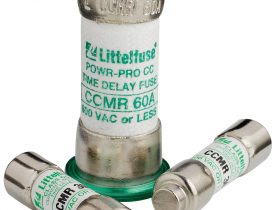
Find Us on Socials